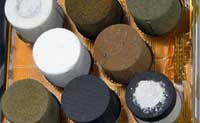Novel nanomaterials developed at Rensselaer Polytechnic Institute are scheduled to blast off into orbit on November 16 aboard Space Shuttle Atlantis.
The project, funded by the US Air Force Multi University Research Initiative (MURI), seeks to test the performance of the nanocomposites in orbit.
Space Shuttle Atlantis will carry the samples to the International Space Station (ISS). The materials will then be mounted to the station’s outer hull in a Passive Experiment Carrier (PEC) and exposed to the rigours of space.
Rensselaer professors Linda Schadler, of the Department of Materials Science and Engineering, and Thierry Blanchet, of the Department of Mechanical, Aerospace, and Nuclear Engineering, worked with a team of researchers from the University of Florida to develop two different types of experimental nanomaterials.
The first new material is a wear-resistant, low-friction nanocomposite, created by mixing nanoscale alumina particles with polytetrafluoroethylene (PTFE), known commercially as Teflon.
Schadler and her research group introduced different fluorine-coated nanoparticles into conventional PTFE. The small amount of additive caused the wear rate of the PTFE to drop by four orders of magnitude without affecting the PTFE’s coefficient of friction. The end result is a stronger, more durable PTFE that is almost as nonstick and slippery as untreated PTFE.
The gained benefit, Schadler said, is the difference between PTFE that can survive sliding along a surface for a few kilometers before wearing away and a nanocomposite that could slide across a surface for more than 100,000km before wearing away.
’In a laboratory setting, the wear rate of the material is four orders of magnitude lower than pure PTFE, which means it is considerably more resistant to wear and tear. Just as important, these advances don’t increase the material’s coefficient of friction, which means the increase in durability won’t come at the expense of creating extra friction,’ Schadler said.

Space Shuttle Atlantis will carry a new Rensselaer nanomaterials experiment to the International Space Station. Samples of novel nanocomposite materials, seen in the photo, will be mounted to the hull of the space station and tested to see how they weather the perils of space
Affixed to the station, which travels at about 27,700kph, the nanocomposite sample will be exposed to ultraviolet radiation and temperatures ranging from -40oC to 60oC. The nanocomposite will be mounted on a tribometer that will measure the friction of the material’s surface. A control sample of the material, protected in a vacuum chamber in the PEC, will also be tested. The apparatus will send data in real time to the ISS laboratory, which in turn will be forwarded to the research team.
The second set of nanomaterials to be launched into space are conductive polymer nanocomposites. During the loading of the tribometers into the PEC for space travel, an opportunity arose to also test the conductivity of carbon nanotube-filled polyamideimide and liquid crystalline polymers as a function of space exposure. The conductive composites were developed by Schadler and former Rensselaer postdoctoral researcher Justin Bult.




Glasgow trial explores AR cues for autonomous road safety
They've ploughed into a few vulnerable road users in the past. Making that less likely will make it spectacularly easy to stop the traffic for...